While we’ve all known that climate change is having an impact on the planet for some time, the reminders are becoming more frequent and more serious, so pushing sustainability is increasingly important for cities and countries around the world.
Whether it’s the large-scale stuff such as investing in renewable energy sources, or down to making sure to recycle properly and buying sustainable clothing rather than investing in fast fashion.
So, which cities in the UK can claim to be the most sustainable, and how does the picture look across the rest of Europe?
The UK’s most sustainable cities
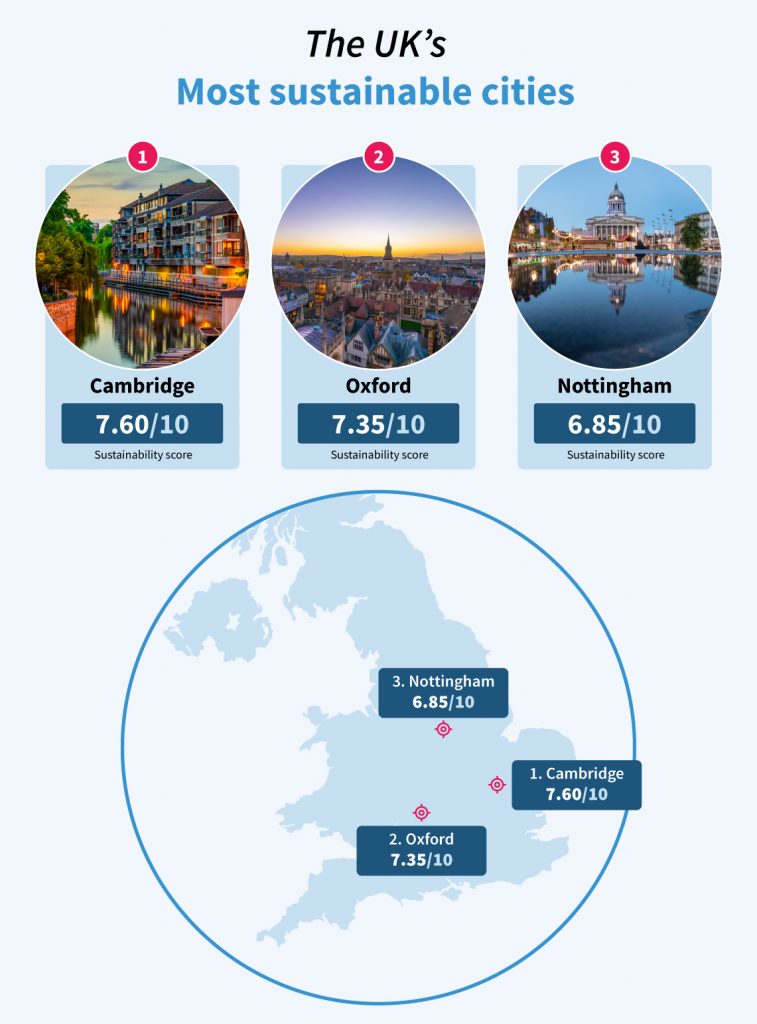
- Cambridge – 7.60 out of 10
Taking the top spot on our list as the UK’s most environmentally friendly city is Cambridge, with a sustainability score of 7.60 out of 10. The city scored highly for the number of parks with 8.8 per 100,000 people.
Cambridge is also planning to build a solar farm in order to fuel its growing fleet of electric refuse collection vehicles, in order to be a carbon-neutral city by 2050.
- Oxford – 7.35 out of 10
Coming second is the home of one of Britain’s oldest and most prestigious universities, Oxford. The city took the top spot for both recycling rate and bodies of water per 100,000 and ranks in the top five for electric vehicle chargers and the least polluted air.
- Nottingham – 6.85 out of 10
The East Midlands city of Nottingham takes third place in our index. The city ranks in the top five for renewable electricity sites, although it is let down by having one of the lowest recycling rates.
Nottingham is aiming to become the UK’s first carbon-neutral city by 2028 and has already installed 40,000 energy-saving measures into homes throughout the city.
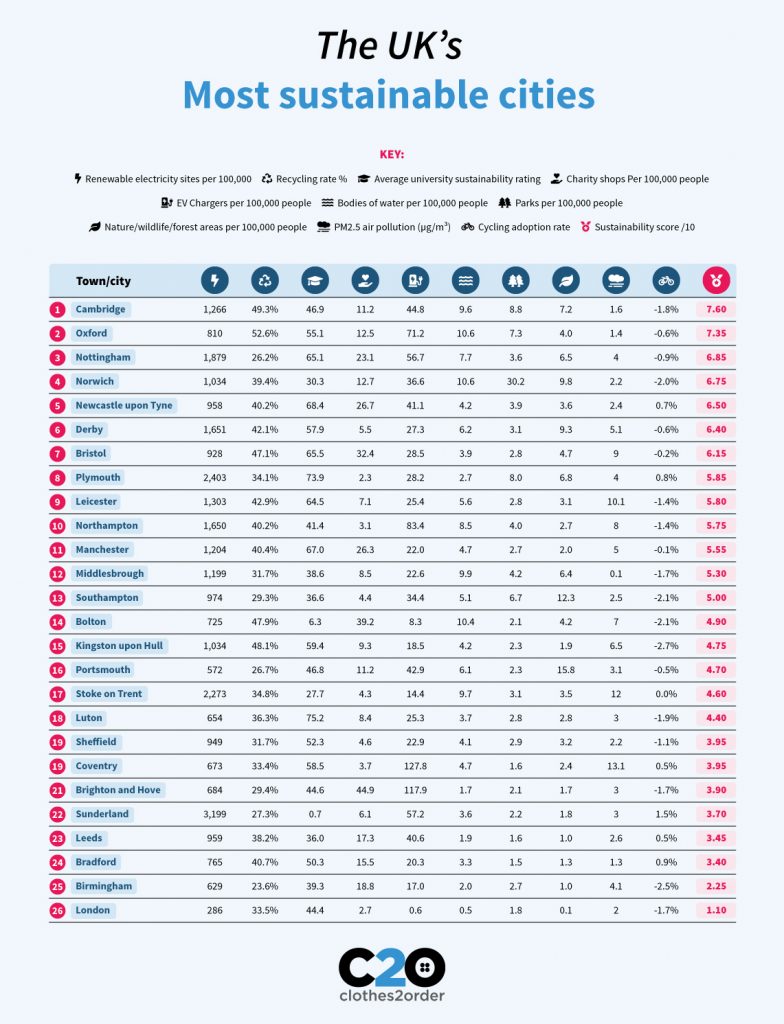
The UK’s most sustainable cities for each factor
Renewable electricity sites – Sunderland (3,199 per 100,000 people)

The city with the most locations dedicated to generating renewable electricity is Sunderland with a total of 8,887, or 3,199 per 100,000 people.
This is no surprise as Sunderland leads the way in terms of renewable energy, generating 73,732 megawatts per hour (around 74 gigawatts) in 2020, mainly through onshore wind farms.
Recycling rate – Oxford (52.6%)

Leading the way in recycling is Oxford with nearly 53% of its waste being reused, recycled or composted, as residents recycled over 24,000 tonnes of household waste in 2021, which exceeds the national average by a whopping 6%.
Oxford is also innovating ways of reusing waste previously thought of as unusable, such as using coffee pods to create fertiliser.
University sustainability – Luton (75.2 out of 100)

While Luton is only home to one university (the University of Bedfordshire) it does happen to be one of the greenest in the country, with an average rating of 75.2 out of 100.
In particular, the uni got full marks for its Environmental Auditing & Management Systems, Energy Sources, and Water Reduction.
Charity shops – Brighton and Hove (44.9 per 100,000 people)

Making sure to reuse things where possible and ensuring that they don’t just go to waste is an important part of sustainability, which is why we also looked at which places had the highest number of charity shops in the area.
Brighton came out on top in this regard, with 44.9 per 100,000 people. Not only that, but it’s also home to one of the best in the UK, according to Vogue.
Electric Vehicle Chargers – Coventry (485 per 100,000 people)

With the sale of new petrol and diesel cars stopping in 2030, it’s important that every city commits to building the infrastructure needed for electric vehicles, including charging points, to build a sustainable future.
Coventry ranks first for this, with 127.8 EV chargers per 100,000 people. It’s not just cars but public transport too, as Coventry has recently invested in a fleet of electric buses and is on track to becoming the first UK city with entirely electric public transport.
Bodies of water – Oxford/Norwich (10.6 per 100,000 people)

Oxford and Norwich are tied in first place for bodies of water with both having 10.6 per 100,000.
It’s no surprise Norwich shares the top spot, surrounded by its eponymous broads, although Oxford has the highest total number of bodies of water, at 16.
City parks – Norwich (30.2 per 100,000 people)

Keeping the air as clean as possible plays an important role in the sustainability of a city, so with this in mind we looked at the number of green spaces each location had to offer.
Norwich had the most parks, with 30.2 per 100,000 people, although the city with the highest total number of parks is London.
Wildlife areas – Portsmouth (15.8 per 100,000 people)

Similarly to parks, wildlife areas play an important part in removing carbon from the atmosphere and looking after them can increase biodiversity too. Taking this into account, we delved into which cities had the most wildlife areas close by.
Portsmouth takes the top spot as the wildest city on our list, with 15.8 wildlife areas per 100,00 people.
Air pollution – Middlesbrough (0.1µg/m³)

One key aspect of sustainability is the impact some environmentally damaging industries and practices can have on our health, with this in mind we looked at the levels of air pollution in each city.
Middlesborough has the cleanest air on our list, at just 0.1 µg/m³. This is a far cry from 2019 when it was discovered the city had the highest average daily air pollution in the North East.
Average cycling adoption rate – Sunderland (1.5%)

Cycling not only benefits your health but is one of the most environmentally-friendly forms of transport, so it’s important to consider it as an aspect of sustainability. Sunderland had the biggest increase of cyclists, with an average of 1.5% of the population cycling once a week.
Despite its importance as a way of cutting emissions, the cycling adoption rate fell in the majority of cities in 2019-2020, likely due to the lockdowns triggered by the COVID pandemic.
Europe’s most sustainable countries
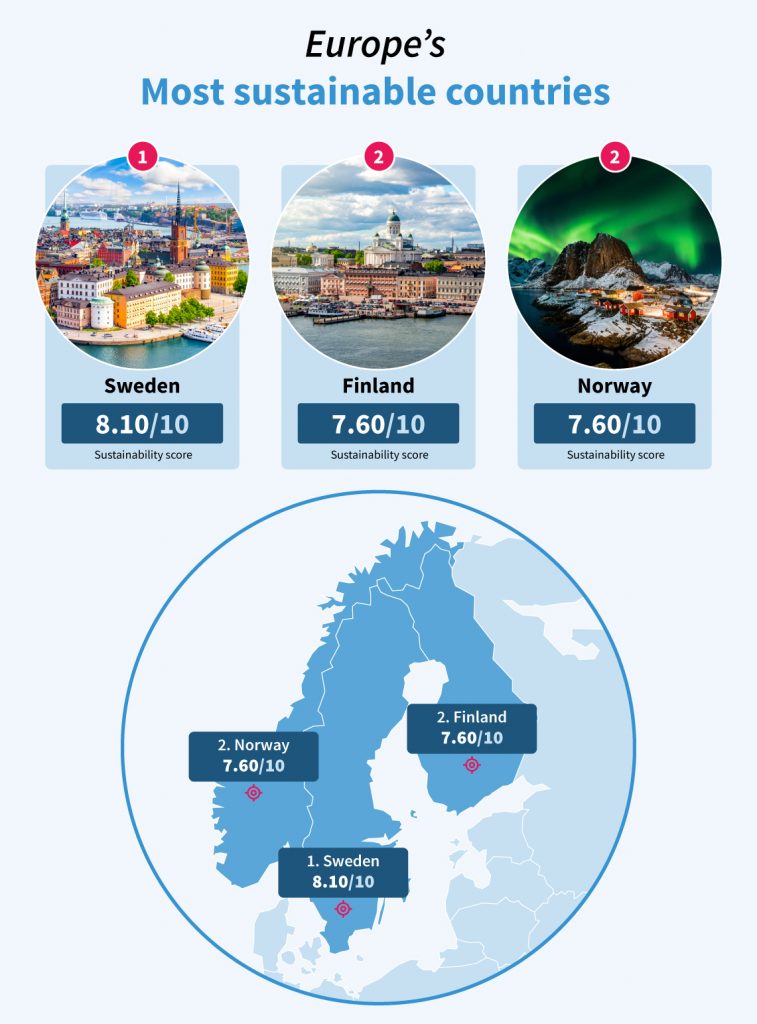
- Sweden – 8.10 out of 10
The highest-ranking country in Europe was Sweden, with a score of 8.10 out of 10, scoring highly across the board.
Most notably, the country had the lowest air pollution of any that we looked at, with just 5 µg/m³ on average.
- Finland – 7.60 out of 10
Sweden’s Nordic neighbour Finland takes second place with a score of 7.60 out of 10; the country has the highest average score when it came to sustainable developments.
Finland is also tied with Sweden for having the lowest level of air pollution at 5µg/m³.
2. Norway – 7.60 out of 10
The third Scandinavian country on our list, Norway ties with Finland with a sustainability score of 7.60.
The Nordic country ranks in the top three for both air pollution levels and university sustainability rating, it also ranks in the top 10 for sustainable development score.
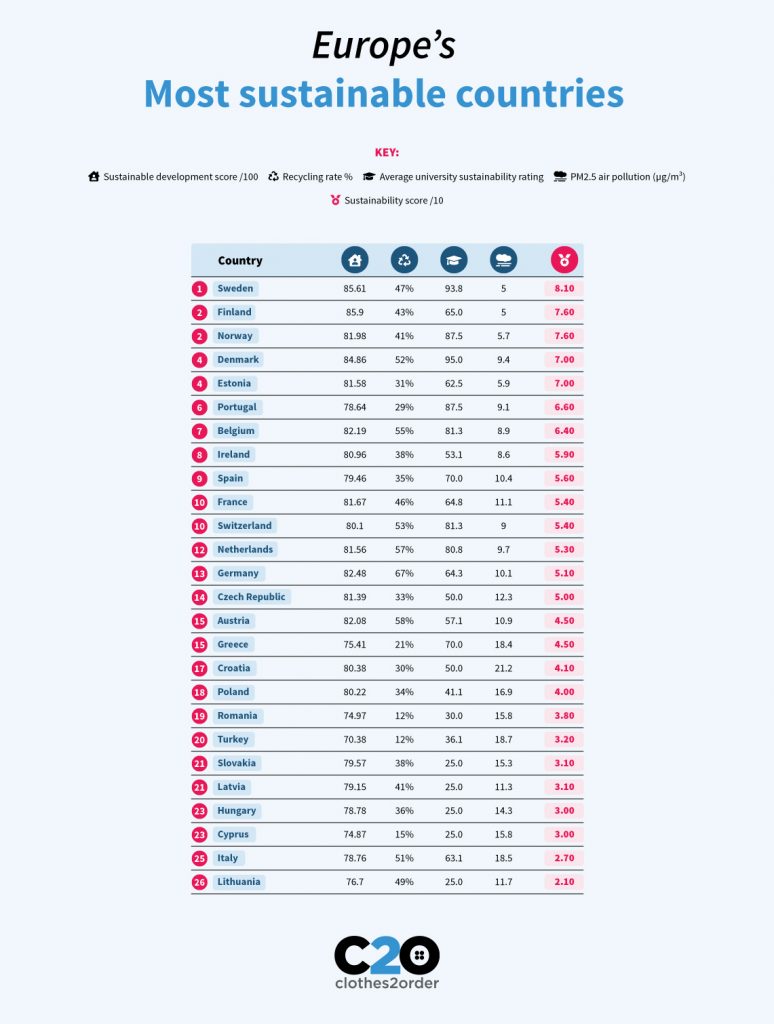
Europe’s most sustainable countries for each factor
Sustainable developments – Finland (85.9 out of 100)

Finland was the highest-ranking country when it came to meeting sustainable development goals, with a score of 85.9 out of 100.
The country has already achieved or is close to achieving most of the UN’s 17 sustainable development goals and has been a global leader in the switch from fossil fuels to greener alternatives.
Recycling rate – Germany (67%)

Germany has a very high recycling rate of just over two thirds, with initiatives in place such as allowing you to recycle bottles and receive some of your money back.
The country has been recycling its waste for 30 years now and has become a role model for other countries around the world.
University sustainability – Denmark (95 out of 100)

Danish universities have an exceptionally high average sustainability score of 95 out of 100, with the likes of the University of Copenhagen, Technical University of Denmark and Aarhus University amongst the highest scoring.
PM2.5 air pollution – Finland/Sweden (5µg/m³)

Neighbouring nations Finland and Sweden were tied when it came to air pollution, with both averaging just 5µg/m³.
Scandinavian nations in general are known for their low emissions so it’s perhaps no surprise to see these two leading the way when it comes to air pollution.
Methodology
UK
Renewable electricity sites – The number of renewable electricity sites per 100,000 people according to the Department for Business, Energy & Industrial Strategy’s regional renewable statistics.
Recycling rate – The percentage of household waste that is sent for reuse, recycling or composting according to:
The Department for Environment, Food & Rural Affairs’ local authority collected waste: annual results tables in England.
SEPA’s household waste data in Scotland.
StatsWales’ annual reuse/recycling/composting rates by local authority for Wales.
The Department of Agriculture, Environment and Rural Affairs’ local authority collected municipal waste management statistics in Northern Ireland.
Average university sustainability rating – An average of the sustainability scores given to each university in the town or city according to People & Planet’s University League.
Charity shops – The number of charity shops per 100,000 people according to Yelp.
EV Chargers – The number of electric vehicle chargers per 100,000 according to Zap Map.
Bodies of water – The number of bodies of water per 100,000 people according to The Department for Environment Food & Rural Affairs catchment data.
Parks – The number of parks according to Tripadvisor per 100,000 people.
Nature/wildlife/forest areas – The number of forests according to Forestry England.
Air pollution – The level of PM2.5 air pollution in µg/m³ according to IQAir.
Cycling adoption – the proportion of people cycling once a week taken from The Department of Transport’s walking and cycling statistics.
Europe
Recycling rate – The municipal waste recycling rate according to the European Environment Agency.
Sustainable development score – The country’s score out of 100 on the Sustainable Development Report, based on their progress toward meeting the UN’s SDGs (Sustainable Development Goals).
Average university sustainability rating – An average of the sustainability scores given to each of the country’s universities listed on the QS World University Rankings 2022.
The rankings give each university an award based on their sustainability, which we converted to scores as follows:
- Gold = 100
- Silver = 75
- Bronze = 50
- Candidate = 25
Air pollution – The level of PM2.5 air pollution in µg/m³ according to IQAir.
Learn more about how to reduce water consumption in the textile industry.

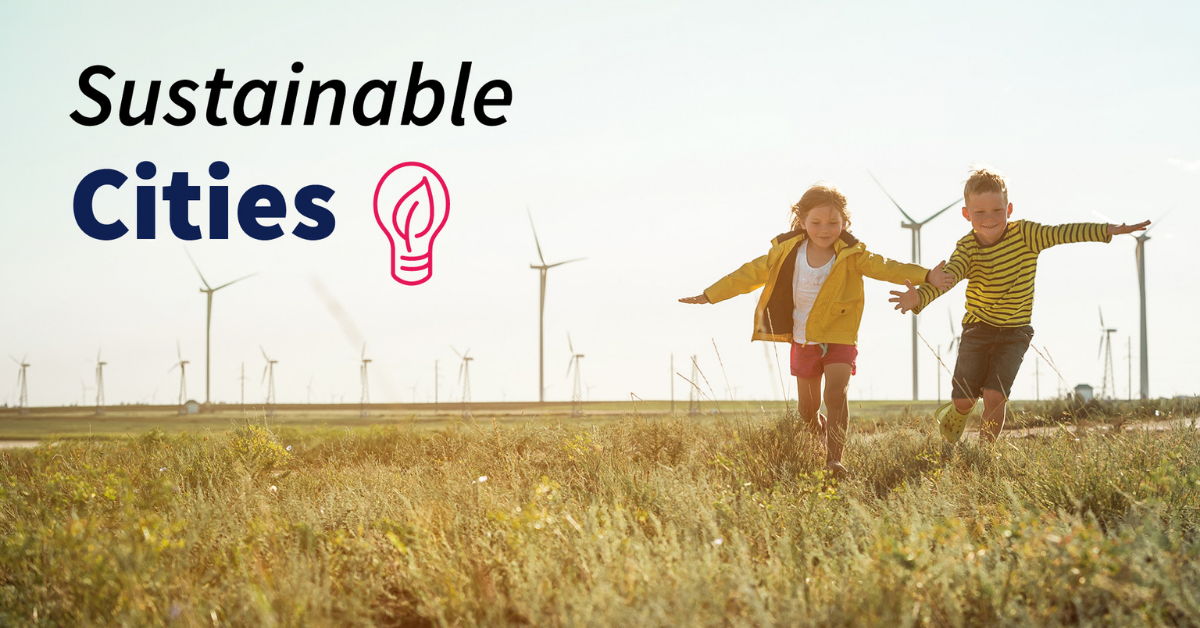

3 comments
[…] The runner up was, predictably, Denmark. With a score of 8.88/10 compared to Sweden’s 9.2/10, they gave the country a run for its money, and Finland scored a respectable 85.9 too. You can read the full report on the website. […]
[…] The winner was, predictably, Sweden. With a score of 9.2/10, compared to Denmark’s 8.88/10. Finland also joined the leaderboard, scoring a respectable 85.9. You can read the full report on the website. […]
[…] the rankings in this study, clothes2order analysed a range of factors including renewable electricity sites, recycling rate, […]
Comments are closed.